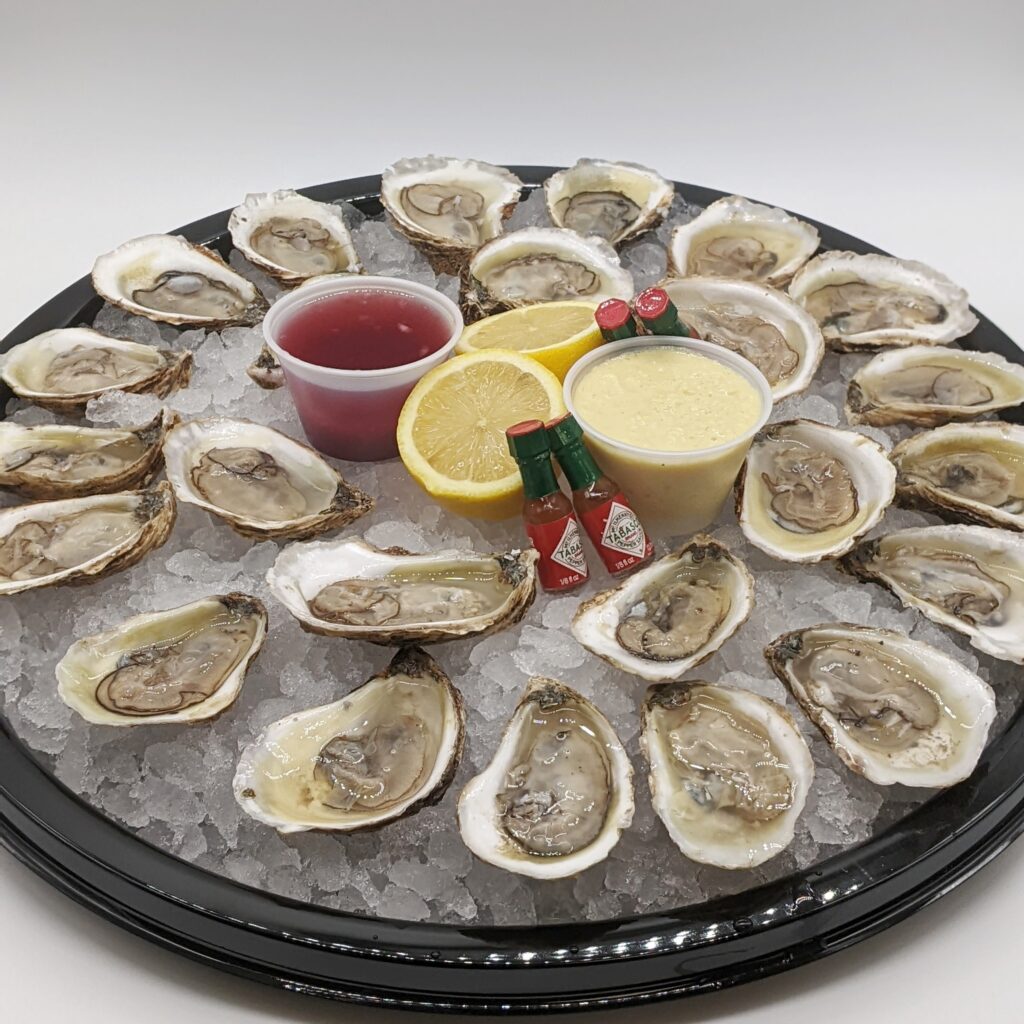Oysters on a plate are a culinary delight enjoyed worldwide. These seafood treasures offer a unique taste and texture.
Oysters have been a prized delicacy for centuries. Their briny flavor and velvety texture make them a favorite at upscale restaurants and casual seafood joints alike. Eating oysters can be an adventure for your taste buds. From raw to cooked, oysters come in many preparations.
They can be served with lemon, mignonette sauce, or even baked with cheese. Understanding the different ways to enjoy oysters can enhance your dining experience. Whether you’re a seafood lover or a curious foodie, exploring oysters on a plate promises a journey through rich flavors and culinary traditions. Dive in and discover the charm of oysters on your plate.
History Of Oysters
The history of oysters is a captivating journey that dates back thousands of years. These bivalve mollusks have been a delicacy across various cultures. From ancient times to modern days, oysters have held a special place in human diets and traditions.
Ancient Consumption
Oysters were consumed by ancient civilizations. Archaeological evidence shows that early humans enjoyed oysters. Shell middens, or heaps of discarded shells, have been found in coastal areas.
- Ancient Greeks: They consumed oysters as a staple food.
- Romans: They prized oysters and considered them a luxury.
- Native Americans: They gathered oysters for both food and tools.
Cultural Significance
Oysters have played a significant role in various cultures. They are more than just food.
In Roman culture, oysters were a symbol of wealth. Emperors hosted lavish feasts with oysters as the highlight.
In Japan, oysters are part of traditional New Year celebrations. They signify good fortune and prosperity.
In France, oysters are a festive treat during Christmas and New Year. They hold a place of honor at the dinner table.
In the United States, oysters were once so abundant they were considered food for the poor. Over time, they became a gourmet item.
| Culture | Significance |
|---|---|
| Ancient Greece | Staple food |
| Rome | Luxury and wealth |
| Japan | Good fortune |
| France | Festive treat |
| United States | From poor to gourmet |
Types Of Oysters
Oysters are a beloved delicacy enjoyed by many seafood lovers. They come in various types, each offering a unique flavor profile. In this section, we will explore the different types of oysters, focusing on Pacific Oysters and Atlantic Oysters.
Pacific Oysters
Pacific Oysters, also known as Crassostrea gigas, are the most common type. They are native to the Pacific coast of Asia but are now farmed worldwide. These oysters are known for their sweet and fruity flavor. They have a firm texture and a slightly briny finish.
| Characteristic | Pacific Oysters |
|---|---|
| Origin | Pacific coast of Asia |
| Flavor | Sweet and fruity |
| Texture | Firm |
| Finish | Slightly briny |
Atlantic Oysters
Atlantic Oysters, or Crassostrea virginica, are native to the east coast of North America. They are known for their strong briny flavor and mild sweetness. These oysters have a plump and tender texture. They are a favorite among many due to their robust taste.
| Characteristic | Atlantic Oysters |
|---|---|
| Origin | East coast of North America |
| Flavor | Strong briny |
| Texture | Plump and tender |
| Finish | Mild sweetness |
Understanding the types of oysters can enhance your dining experience. Whether you prefer the sweet Pacific or the briny Atlantic, there’s an oyster for every palate.
Nutritional Benefits
Oysters are more than just a delicious treat from the sea. They are packed with nutrients that offer many health benefits. These small shellfish are rich in vitamins and high in minerals, making them a great addition to your diet.
Rich In Vitamins
Oysters provide a significant amount of essential vitamins. They are particularly high in vitamin B12, which helps maintain healthy nerve cells and supports brain function. A serving of oysters can provide more than 100% of your daily vitamin B12 needs.
Other important vitamins found in oysters include vitamin D, which supports bone health, and vitamin A, which is crucial for vision and immune function. Here’s a quick overview of the vitamins in oysters:
| Vitamin | Health Benefit |
|---|---|
| Vitamin B12 | Supports nerve cells and brain function |
| Vitamin D | Promotes bone health |
| Vitamin A | Essential for vision and immune function |
High In Minerals
Oysters are also high in many essential minerals. They are an excellent source of zinc, which is vital for a healthy immune system and wound healing. Zinc also supports normal growth and development during pregnancy, childhood, and adolescence.
In addition to zinc, oysters are rich in iron, which helps transport oxygen in the blood. They also contain selenium, which protects cells from damage, and copper, which aids in the production of red blood cells. Here’s a breakdown of the minerals found in oysters:
- Zinc: Supports immune health and wound healing
- Iron: Transports oxygen in the blood
- Selenium: Protects cells from damage
- Copper: Helps produce red blood cells
Eating oysters can help you meet your daily mineral needs and support overall health. This makes them a nutritious and delicious choice for your plate.

Credit: www.themediterraneandish.com
Sourcing Fresh Oysters
Finding fresh oysters is essential for a delightful seafood experience. The journey from ocean to plate involves careful selection and responsible practices. Let’s explore how to source the best oysters with these important considerations.
Sustainable Practices
Using sustainable practices ensures the long-term health of oyster populations. Sustainable oyster farming maintains a balance in the ecosystem. This practice protects the environment and provides high-quality oysters.
Look for oysters from farms that use eco-friendly methods. These methods include recycling shells and controlling water quality. Choosing sustainably sourced oysters helps support responsible seafood consumption.
Trusted Suppliers
Working with trusted suppliers guarantees the freshness and quality of oysters. These suppliers have a reputation for delivering top-notch seafood. They follow strict guidelines to maintain the highest standards.
To find reliable suppliers, consider the following:
- Check for certifications from recognized organizations.
- Read reviews and testimonials from other customers.
- Ask about their sourcing and handling practices.
By partnering with reputable suppliers, you can ensure that the oysters on your plate are fresh, safe, and delicious.
Summary
Sourcing fresh oysters involves understanding sustainable practices and working with trusted suppliers. By focusing on these key areas, you can enjoy the best oysters while supporting responsible seafood practices.
Preparing Oysters
Preparing oysters can be a delightful experience. It’s essential to have the right techniques to ensure safety and enhance taste. This section covers the basics of shucking and cleaning oysters to get them ready for your plate.
Shucking Techniques
Shucking oysters requires a bit of skill and the right tools. Follow these steps to shuck oysters safely and effectively:
- Gather tools: Oyster knife, gloves, and a towel.
- Place the oyster: Hold the oyster with the flatter side up.
- Insert the knife: Push the knife into the hinge of the oyster.
- Twist and pop: Twist the knife to pop the shell open.
- Slide the knife: Cut the muscle to separate the top shell.
- Remove the top shell: Discard the top shell and clean the knife.
- Cut the bottom muscle: Slide the knife under the oyster to free it.
Cleaning Methods
Clean oysters properly to remove sand and debris. Here’s how:
- Rinse: Rinse oysters under cold running water.
- Scrub: Use a brush to scrub the shells.
- Inspect: Check for any remaining debris.
- Drain: Place oysters on a towel to drain excess water.
Use these simple steps to enjoy fresh, clean oysters on a plate. Proper preparation enhances the experience and ensures safety. Happy shucking!

Credit: annapolispottery.com
Serving Suggestions
Oysters on a plate are a delightful treat for seafood lovers. There are many ways to serve them, ensuring a fresh and flavorful experience. Below are some serving suggestions that will make your oyster dish stand out.
Raw With Condiments
Serving oysters raw is a classic choice. Fresh oysters have a unique taste that many people enjoy. To enhance their flavor, pair them with a variety of condiments.
- Lemon Wedges: A squeeze of fresh lemon adds a tangy zest.
- Mignonette Sauce: A mix of vinegar, shallots, and black pepper.
- Hot Sauce: Adds a spicy kick to the briny oysters.
- Horseradish: Gives a sharp, pungent flavor.
Place the condiments in small bowls around the oysters. This allows everyone to customize their own bites. Serve on a bed of crushed ice to keep them fresh and cool.
Cooked Variations
Cooking oysters brings out different flavors and textures. Here are some popular ways to enjoy cooked oysters:
- Grilled Oysters: Place oysters on the grill until the shells open. Add garlic butter and herbs for extra flavor.
- Baked Oysters: Top with breadcrumbs, cheese, and herbs. Bake until golden brown for a crispy delight.
- Oyster Stew: Cook oysters in a creamy broth with butter, onions, and celery. Serve hot with crusty bread.
- Fried Oysters: Coat in cornmeal or breadcrumbs and fry until golden and crispy. Serve with tartar sauce or a spicy aioli.
Cooked oysters offer a variety of textures and flavors. Each method brings out a unique aspect of the oyster’s taste.
Pairing With Beverages
Pairing oysters with the right beverage can elevate your dining experience. The right drink enhances the flavors of the oysters, creating a memorable meal. Let’s explore the best pairings to complement your oysters on a plate.
Wine Pairings
Wine is a classic choice for pairing with oysters. White wine works best as it complements the briny taste of oysters. Here are some top picks:
- Chablis – Its crisp acidity matches the oyster’s natural salinity.
- Muscadet – Known for its mineral notes, it pairs well with oysters.
- Champagne – The bubbles and acidity make a delightful combination.
Consider the following table for a quick reference:
| Wine | Notes |
|---|---|
| Chablis | Crisp, acidic, mineral |
| Muscadet | Light, mineral, refreshing |
| Champagne | Bubbly, acidic, festive |
Beer And Spirits
Beer and spirits can also be excellent choices for oysters. They offer a different flavor profile that can enhance the oyster experience.
- Stout – Its creamy texture complements the briny oysters.
- Pilsner – Light and crisp, it refreshes the palate.
- Vodka – Clean and neutral, it highlights the oyster’s natural taste.
- Gin – The herbal notes add complexity to the oysters.
Here’s a quick guide:
- Stout: Creamy, rich texture.
- Pilsner: Light, crisp, refreshing.
- Vodka: Clean, neutral.
- Gin: Herbal, complex.
Choosing the right beverage can enhance your oyster experience. Whether you prefer wine, beer, or spirits, each pairing offers a unique way to enjoy oysters.

Credit: www.hhfreshfish.com
Health Considerations
Oysters are a delicious and nutritious seafood choice. They offer many health benefits but also come with some considerations. Knowing these can help you enjoy oysters safely.
Allergy Information
Some people are allergic to shellfish, including oysters. Shellfish allergies can cause severe reactions. If you’re unsure, consult a doctor before trying oysters. Symptoms of an oyster allergy include:
- Hives or skin rash
- Swelling of the lips, face, or throat
- Difficulty breathing
- Stomach pain or nausea
If you experience any of these, seek medical help immediately.
Safe Consumption Tips
To enjoy oysters safely, follow these tips:
- Buy from trusted sources: Ensure the oysters are fresh and from reputable sellers.
- Check the shell: Fresh oysters should have tightly closed shells. If open, tap them. They should close immediately.
- Keep them cold: Store oysters in the refrigerator. Use them within two days.
- Cook thoroughly: Cooking kills harmful bacteria. Avoid eating raw oysters if you have a weakened immune system.
- Watch for signs of spoilage: Spoiled oysters have a strong, unpleasant smell. Do not eat them.
By following these tips, you can reduce the risk of foodborne illness.
Oysters are a great source of protein and minerals. Yet, they require careful handling to avoid health issues.
Frequently Asked Questions
What Are The Health Benefits Of Eating Oysters?
Oysters are rich in zinc, iron, and vitamin B12. They support immune function, boost energy, and improve heart health. They’re also low in calories.
How To Serve Oysters On A Plate?
Serve oysters on a bed of crushed ice. Add lemon wedges, cocktail sauce, and mignonette. Ensure they are fresh and cold.
Are Oysters Good For Weight Loss?
Yes, oysters are low in calories and high in protein. They help you feel full longer and support weight loss.
What Do Fresh Oysters Taste Like?
Fresh oysters taste briny, slightly sweet, and have a buttery texture. The flavor varies by region and water quality.
Conclusion
Oysters on a plate bring a unique and delightful taste experience. Their fresh, briny flavor excites the palate. Perfect for special occasions or a simple treat. Enjoy them raw, grilled, or baked. Each method offers a different taste sensation. Remember to savor every bite.
Share with friends and family for a memorable experience. Oysters add elegance to any meal. So, next time you see oysters, give them a try. You might discover a new favorite dish.




